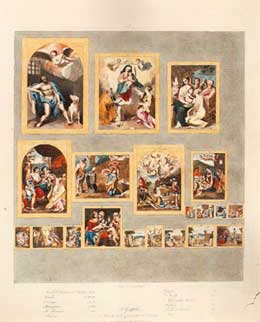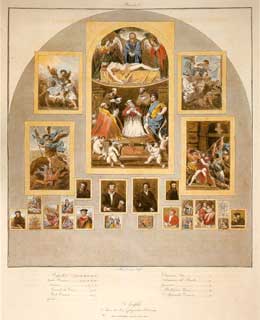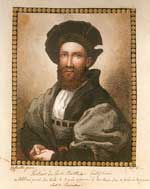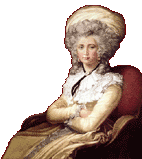The artist
Maria Cosway has been an eclectic protagonist as a collector and in the Grand Tour culture. Yet, her works haven't been studied enough to let us understand wholly her complex and extraordinary intellectual personality. (For her artistic activity consult: G. Barnett, Richard and Maria Cosway: A Biography; with a Foreword by Daphne Foskett, Tiverton 1995; see also the more recent and updated: Maria e Richard Cosway, edited by Tino Gipponi, Umberto Allemandi, Torino 1998).
Great attention must be paid to what has been called “the red morocco folder”: it was a manuscript album in which Maria had submitted an advance project to the collaborators of Napoleon; this project was to produce etchings of those Italian paintings which were now kept at the Louvre after the Napoleonic plunderings, and were waiting to be finally arranged in the Main Gallery at the new born Napoleon Museum. The collaborators of Napoleon agreed to undertake the editing of the project. Wescher tells us that, from that year on, the miniature painter, also encouraged by David, was responsible for “carrying out the engravings in the Louvre Gallery for an important folio-work; its first volume, dedicated to a part of the paintings by the Italian school, had been printed in the same year, 1802” (P. Wescher, Kunstraub unter Napoleon, Berlino 1976, translated in Italian as: I furti d’arte. Napoleone e la nascita del Louvre, Torino 1988, pp. 93-94.).


Each booklet should have contained some of the plates with the engravings, in watercolour or in black, that reproduced the paintings with a short description of each. The engravings had all been made by Maria's hands; she followed a technique she had achieved, based on the Rosaspina method (M. Marubbi, Maria Cosway: Il profilo intellettuale dalle sue memorie, in Maria e Richard Cosway, pp.69-102.). Maria decided to engrave by herself all the etchings, after she had visited in the company of Fesh, the art school settled in the establishment of Francesco Piranesi, son of the well-known Giambattista. She found herself annoyed by the poor results and by the ulterior purposes for which this school had been created. In the same way she touched up the watercolours because she wasn't satisfied by the painters' work.
Through her works we can get an idea of how the exhibition arrangement was made at the moment of that great incoming of the art pieces, either Italian or not. In fact, it crystallizes a way to exhibit which later underwent further changes, due to the fact that some of the works were returned to the countries were they came from. The “folder” reproduces in some cases just one work per page, in others a set of paintings, of different sizes, all numbered and with a short historical note, that gives us information such as the artist, the title of the work and, for example, also outlines the transfer of painting onto the canvas.
 We can find works by Raffaello and Correggio, for whom Maria felt deep veneration, and then paintings by Giulio Romano, Tiziano, Parmigianino and Leonardo, but also by Procaccini, by Fetti, Sebastiano del Piombo, Pietro da Cortona, Veronese, Peruzzi, Reni, Guercino, Mantegna and Del Frate. Cosway also reproduced works by foreign painters who had worked in Italy and who had benefitted from an endless fascination, like Rubens, Paris Bordon and Van Dyck. Of this last painter she engraved the very famous portrait of cardinal Bentivoglio in Palazzo Pitti, one of those “Italian reflections” that now peeps out from the Ronconi exposition in Milan. Besides some books from the Cosway Library, there's also Maria's Diary, in more than one volume, that is interesting for the part written in Paris between 1802 and 1803: it gives us information about the daily visits of the artist to the Louvre, her friendship with David, her relationship with Napoleon's collaborators.
We can find works by Raffaello and Correggio, for whom Maria felt deep veneration, and then paintings by Giulio Romano, Tiziano, Parmigianino and Leonardo, but also by Procaccini, by Fetti, Sebastiano del Piombo, Pietro da Cortona, Veronese, Peruzzi, Reni, Guercino, Mantegna and Del Frate. Cosway also reproduced works by foreign painters who had worked in Italy and who had benefitted from an endless fascination, like Rubens, Paris Bordon and Van Dyck. Of this last painter she engraved the very famous portrait of cardinal Bentivoglio in Palazzo Pitti, one of those “Italian reflections” that now peeps out from the Ronconi exposition in Milan. Besides some books from the Cosway Library, there's also Maria's Diary, in more than one volume, that is interesting for the part written in Paris between 1802 and 1803: it gives us information about the daily visits of the artist to the Louvre, her friendship with David, her relationship with Napoleon's collaborators.
A large number of Cosway's reproductions are, instead, left in Lodi: these are copies of Italian masters, or artists that were active in Italy, like Rubens. These works were produced in the early years of her education while she visited Florence galeries, or in her stays during the Grand Tour eventful years, like her drawing from Tintoretto's Last Supper of the Scuola Grande of San Rocco.
The folder prints that Maria obtained from the Venetian's works, that had partly arrived at the Louvre, were due to the artistic plunder during the Italian Napoleonic Campaign in 1796; more precisely, it occurred a year later when the French revolutionaries, after the rebellion against the Jacobeans, wanted to avenge the Veronean Easter days; they overthrew the Serenissima Venice Republic, which underwent a sacking of many masterpieces and which was humiliated by the removal of the bronze lion and of the four horses that adorned St. Marco's Basilica façade. In between the prints influenced by Tiziano that are preserved in the folder, we can include the Deposizione of 1525, ordered by the Gonzagas, and works that are part of the Louis XIV's collection such as the “Donna allo specchio”, “L'Uomo col guanto”, the so-called “Vierge au Lapin”, “La cena in Emmaus” and “L'uomo con la mano alla cintura”.
Cosway who felt a deep veneration for Tiziano, complained about the delay in transporting to Lodi the paintings that Fesh had promised her, referring in an alarmed way to the presence of “two small Tiziano's which need to be arranged” (Arch. Cosway's Foundation Lodi, Maria Cosway to Cardinal Fesh, 26 Febraury 1812, copied in Diary D.). She would also admire Vecellio to such an extent as to commit a monument of this painter to her friend Canova, monument that the sculptor couldn't finally fulfill before his death.
In Maria Cosway's engravings there are three cross-references to Paolo Veronese; two of these are very small in size and nowadays are not included in the Caliari cataloge, while the third (which we can recognize even if the Cosway print is reversed), represents the fall of Christ at the feet of the cross; this is a masterpiece that already appeared in the Louis XIV collection and that had been probably painted after a similar devout painting done by Dresda, but considered not authentic.
More interesting are the etchings which reproduce the works by Tiziano, that arrived in Paris after the Napoleonic plunders, like the Incoronazione di spine of 1540 which till 1797 was in the Santa Corona Chapel in Santa Maria delle Grazie in Milan; a Portrait of un uncertain author but that Cosway recognizes such as Vecellio, and the lost Uccisione di San Pietro martire. This last work is the most significant for its historical evidence but also for its chromatic reminiscences that recall the extraordinary altar piece that Tiziano gave, on the 27th of April 1530, to the Dominicans of San Giovanni e Paolo; Tiziano had surpassed Palma il Vecchio and Pordenone in a competitive examination announced by the Venitian Brotherhood of San Pietro Martire.
This painting had been removed during the Napoleonic repressions and transported to Paris; it then returned to Italy after Napoleon's fall – meanwhile the painting had been transfered on a canvas – and was placed again in the previous church where it came from, but this time it was put in Rosario's Chapel, because on the altar an accurate copy by, probably, Cigoli had been placed. Vecellio's canvas was then destroyed by a fire that on the 16th of august 1867 devastated Rosario's Chapel, where the altar piece had been again sheltered to be restored. What's left of this masterpiece are Vasari's praises which sing of it as “the major and most complete, the best thought and carried out, beyond which Tiziano, in all his life, never did before”, but also some antique copy, like the one now on the altar, probably by Loth.
Tiziano's expedient, which presents the protagonists of the massacre on the edge of a big and obscure wood that stands out against the background, has been handed down graphically from an engraving by Martino Rota da Sebenico. He's also the author of another painting influenced by Tiziano, and precisely from the Tributo della moneta, a work that had in 1625 attracted Van Dyck's interest (whose version, which is now exposed in the Sala delle Cariatidi in Milan, of the same subject is a true tribute to Vecellio), when the original canvas of Tiziano couldn't be seen because in that period it was in Spain.
For its subject and its icon statement L'Uccisione di San Pietro Martire is remembered also in the Brescia area, for example by the canvas, with the same name, attribuited by Anelli to Antonio Gandino, a work which was restored in 2002 and kept in the church of San Pietro da Verona in Castrezzato; and also by another contemporary copy which appeared among the Venetian works put up for auction on the 7th of June 2002 by Christie's in New York (precisely no. 586, sale no. 1090), as well as other canvases of the same period which many people have enjoyed directly.
For all these signs and for those that are given by Tiziano's pen studies, that are kept in Lille, it's maybe possible to pick up the composition analogies between that work and others by Vecellio painted in the twenties and the thirties of XVI century. These works are the already mentioned Deposizione, or the Madonna con Bambino, San Giovannino e Santa Caterina di Londra, that had been painted for the duke of Mantova, or the Adorazione dei Pastori for Francesco Maria della Rovere, now in Palazzo Pitti.
The etching by Cosway kept in the folder could be, in the same sense, a further link that gathers information about the reconstruction of Tiziano's altar; its chromatic quality gives us the chance to get very near to the lost original, more than the antique copies can ever do. It is, in fact, the result of a systematic operation of cataloguing that's moved by a new spirit of stocktaking and by a mind totally dedicated to the artistic study, nearly philological, of the Renaissance masters.
Taken from:
Vera Bugatti (5th of June 2004)
Memorie veneto-cinquecentesche dal portafoglio di Maria Cosway
From 1781 to 1789 Maria went on with her activity as a painter, exhibiting more than forty-two of her paintings1 at the Royal Academy, a site where the exhibitions of the best artists were shown.
![]()
Fondazione Maria Cosway Via Paolo Gorini, 6 26900 Lodi C.F. 84511920153

